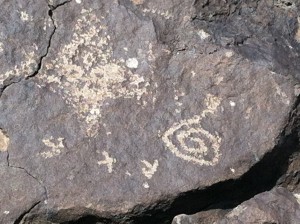

While in Albuquerque, New Mexico, I jumped at the opportunity to check out a gathering of petroglyphs surrounded by a modern residential subdivision. Believe it or not, one had only to walk into the protected area (behind people’s backyard fences!) to see them.
Etched onto dark-colored (sometimes black) volcanic boulders that resembled a collection of piles a giant might have created, the etchings stand out against the darkness of the rocks and remain where they were originally drawn, shining in the sun for all to see. It was easy to speculate on the artists who created them and how they must have lived many years ago.
I spotted a figure that had to be a representation of a rabbit, and another rock showing birds and a coiled snake, very likely confirming that rattlers existed there, too, as well as a grouping of people’s faces, perhaps suggesting a gathering to share the bounty of the gardens of the Pueblo peoples who inhabited the area then and now. What I don’t know are which Pueblo members created these etchings on the rocks. Within the boundaries of New Mexico can be found the artifacts of nearly twenty different Pueblo peoples, each with their own language, though their way of life was similar enough to other American Indians that they sometimes met with more well-known tribes (such as the Zuni, Navaho, and Hopi) in large groups.






